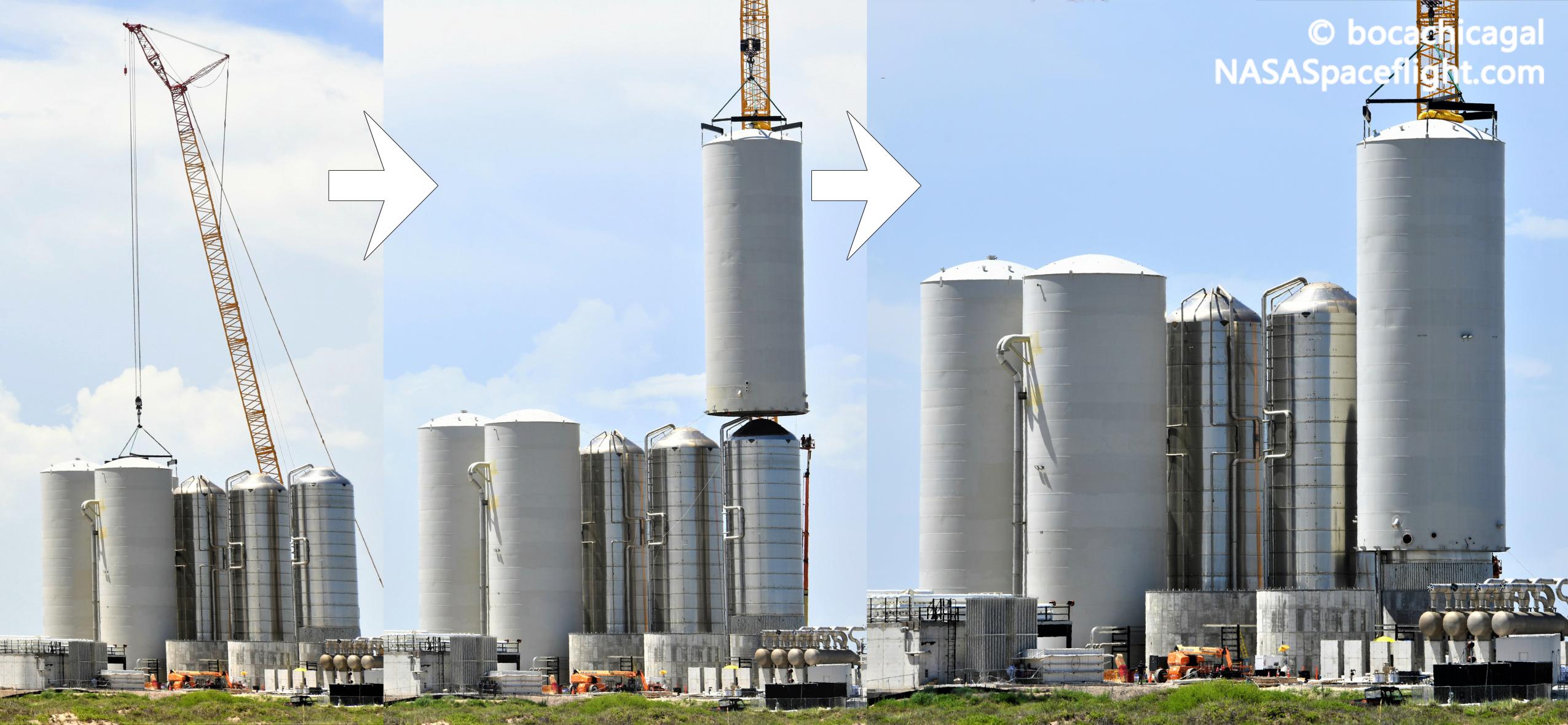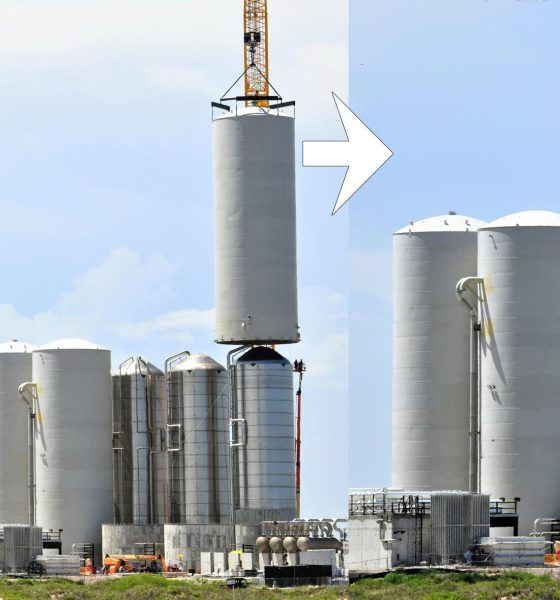

News
SpaceX ‘sleeves’ Starship-derived propellant tank for the first time – here’s why
In a small but important step towards activating a pad capable of launching the largest and most powerful rocket ever built, SpaceX has ‘sleeved’ one of its Starship-derived propellant storage tanks for the first time.
Starship is a fully-reusable, two-stage liquid rocket designed to ultimately cut the cost of orbital launch by at least one magnitude, opening the door for humanity’s sustainable expansion to Earth orbit, the Moon, Mars, and even beyond. To accomplish that lofty feat, it has to be a massive rocket. Measuring approximately 120m (~395 ft) tall and 9m (~30 ft) wide, Starship and Super Heavy will weigh on the order of 300 metric tons (~675,000 lb) when empty.
Once filled to the brim with cryogenic liquid methane (CH4) and liquid oxygen (LOx) propellant and gas, though, a two-stage Starship will easily weigh more than 5000 tons (11 million lb) shortly before and after liftoff. Further, SpaceX wants to be able to launch at least two Starships from Boca Chica in rapid succession. To meet the staggering needs of back-to-back Starship launches, SpaceX has thus had to design and build what will be the world’s largest launch pad tank farm.
Work on that tank farm is already well underway, though progress has been slower than expected. The site’s foundation and a few associated blockhouses were mostly completed by January 2021. By early April, the company had completed the first of at least seven steel propellant storage tanks at its Starship factory and rolled it to the launch pad for installation.
Notably, SpaceX chose to manufacture those storage tanks itself and ended up building structures virtually identical to the tanks that already make up most of flightworthy Starship and Super Heavy airframes. Depending on whether they’re meant to store liquid oxygen or methane, the seven tanks SpaceX is building are either 26 or 30 meters (85 or 100 feet) tall – though the concrete mounts they’re affixed to at the launch site are sized such that all storage tanks will have the same final height.
Of course, being made with the same tools and out of the same steel as Starship and Super Heavy, that means that SpaceX’s custom storage tanks are little more than 4mm (~1/6″) thick steel shells – about as bad as it gets for keeping cryogenic rocket fuel… cryogenic. If SpaceX were to simply use those unmodified tanks, it would be almost impossible to store Starship fuel for more than a few hours – and maybe just a few minutes – without it warming up past the point of usability.
As such, SpaceX’s final Starship tank farm design involves seven Starship-derived storage tanks and seven contractor-built tank sleeves. Measuring around 12m (~40 ft) wide and 40m (~130 ft) tall, those “cryo shells” will enclose all seven SpaceX-built tanks, allowing the company to fill the 1.5m (~5 ft) gap between them with an insulating solid, gas, or some combination of both. With those shells and insulation, SpaceX’s custom-built Starship tank form should be more than capable of storing cryogenic liquid oxygen and methane for days or even weeks.
As of August 5th, SpaceX has installed three of Starship’s custom ground supply equipment (GSE) tanks (with a fourth moved onsite on Thursday), moved two ‘cryo shells’ to temporary storage spots at the pad, and installed one cryo shell that actually turned out to be a million-gallon water tank. On Thursday, SpaceX ‘sleeved’ one of those storage tanks for the first time ever, marking an important milestone towards the activation of a tank farm capable of supporting Starship’s orbital launch debut. Another four sleeves are more or less complete, with the eighth and final sleeve likely just a week or two away from completion.
A fifth GSE tank is also more or less complete, leaving two more to go. However, with some basic math, it’s possible to determine that SpaceX’s orbital launch pad likely only needs five cryogenic tanks (three oxygen, two methane) – and possibly as few as four – to support Starship’s first orbital test flight(s). With SpaceX finally beginning to install tank sleeves, it’s possible that that four or five-tank milestone – and the first tests of SpaceX’s custom, unproven storage solution – are now much closer at hand.

News
Tesla China delivery centers look packed as 2025 comes to a close
Needless to say, it appears that Tesla China seems intent on ending 2025 on a strong note.

Tesla’s delivery centers in China seem to be absolutely packed as the final days of 2025 wind down, with photos on social media showing delivery locations being filled wall-to-wall with vehicles waiting for their new owners.
Needless to say, it appears that Tesla China seems intent on ending 2025 on a strong note.
Full delivery center hints at year-end demand surge
A recent image from a Chinese delivery center posted by industry watcher @Tslachan on X revealed rows upon rows of freshly prepared Model Y and Model 3 units, some of which were adorned with red bows and teddy bears. Some customers also seem to be looking over their vehicles with Tesla delivery staff.
The images hint at a strong year-end push to clear inventory and deliver as many vehicles as possible. Interestingly enough, several Model Y L vehicles could be seen in the photos, hinting at the demand for the extended wheelbase-six seat variant of the best-selling all-electric crossover.
Strong demand in China
Consumer demand for the Model Y and Model 3 in China seems to be quite notable. This could be inferred from the estimated delivery dates for the Model 3 and Model Y, which have been extended to February 2026 for several variants. Apart from this, the Model Y and Model 3 also continue to rank well in China’s premium EV segment.
From January to November alone, the Model Y took China’s number one spot in the RMB 200,000-RMB 300,000 segment for electric vehicles, selling 359,463 units. The Model 3 sedan took third place, selling 172,392. This is quite impressive considering that both the Model Y and Model 3 are still priced at a premium compared to some of their rivals, such as the Xiaomi SU7 and YU7.
With delivery centers in December being quite busy, it does seem like Tesla China will end the year on a strong note once more.
News
Tesla Giga Berlin draws “red line” over IG Metall union’s 35-hour week demands
Factory manager André Thierig has drawn a “red line” against reducing Giga Berlin’s workweek to 35 hours, while highlighting that Tesla has actually increased its workers’ salaries more substantially than other carmakers in the country.

Tesla Giga Berlin has found itself in a new labor dispute in Germany, where union IG Metall is pushing for adoption of a collective agreement to boost wages and implement changes, such as a 35-hour workweek.
In a comment, Giga Berlin manager André Thierig drew a “red line” against reducing Giga Berlin’s workweek to 35 hours, while highlighting that Tesla has actually increased its workers’ salaries more substantially than other carmakers in the country.
Tesla factory manager’s “red line”
Tesla Germany is expected to hold a works council election in 2026, which André Thierig considers very important. As per the Giga Berlin plant manager, Giga Berlin’s plant expansion plans might be put on hold if the election favors the union. He also spoke against some of the changes that IG Metall is seeking to implement in the factory, like a 35-hour week, as noted in an rbb24 report.
“The discussion about a 35-hour week is a red line for me. We will not cross it,” Theirig said.
“(The election) will determine whether we can continue our successful path in the future in an independent, flexible, and unbureaucratic manner. Personally, I cannot imagine that the decision-makers in the USA will continue to push ahead with the factory expansion if the election results favor IG Metall.”
Giga Berlin’s wage increase
IG Metall district manager Jan Otto told the German news agency DPA that without a collective agreement, Tesla’s wages remain significantly below levels at other German car factories. He noted the company excuses this by referencing its lowest pay grade, but added: “The two lowest pay grades are not even used in car factories.”
In response, Tesla noted that it has raised the wages of Gigafactory Berlin’s workers more than their German competitors. Thierig noted that with a collective agreement, Giga Berlin’s workers would have seen a 2% wage increase this year. But thanks to Tesla not being unionized, Gigafactory Berlin workers were able to receive a 4% increase, as noted in a CarUp report.
“There was a wage increase of 2% this year in the current collective agreement. Because we are in a different economic situation than the industry as a whole, we were able to double the wages – by 4%. Since production started, this corresponds to a wage increase of more than 25% in less than four years,” Thierig stated.
News
Tesla is seeing a lot of momentum from young Koreans in their 20s-30s: report
From January to November, young buyers purchased over 21,000 Teslas, putting it far ahead of fellow imported rivals like BMW and Mercedes-Benz.

Tesla has captured the hearts of South Korea’s 20s-30s demographic, emerging as the group’s top-selling imported car brand in 2025. From January to November, young buyers purchased over 21,000 Teslas, putting it far ahead of fellow imported rivals like BMW and Mercedes-Benz.
Industry experts cited by The Economist attributed this “Tesla frenzy” to fandom culture, where buyers prioritize the brand over traditional car attributes, similar to snapping up the latest iPhone.
Model Y dominates among young buyers
Data from the Korea Imported Automobile Association showed that Tesla sold 21,757 vehicles to the 20s-30s demographic through November, compared to BMW’s 13,666 and Mercedes-Benz’s 6,983. The Model Y led the list overwhelmingly, with variants like the standard and Long Range models topping purchases for both young men and women.
Young men bought around 16,000 Teslas, mostly Model Y (over 15,000 units), followed by Model 3. Young women followed a similar pattern, favoring Model Y (3,888 units) and Model 3 (1,083 units). The Cybertruck saw minimal sales in this group.
The Model Y’s appeal lies in its family-friendly SUV design, 400-500 km range, quick acceleration, and spacious cargo, which is ideal for commuting and leisure. The Model 3, on the other hand, serves as an accessible entry point with lower pricing, which is valuable considering the country’s EV subsidies.
The Tesla boom
Experts described Tesla’s popularity as “fandom culture,” where young buyers embrace the brand despite criticisms from skeptics. Professor Lee Ho-geun called Tesla a “typical early adopter brand,” comparing purchases to iPhones.
Professor Kim Pil-soo noted that young people view Tesla more as a gadget than a car, and they are likely drawn by marketing, subsidies, and perceived value. They also tend to overlook news of numerous recalls, which are mostly over-the-air software updates, and controversies tied to the company.
Tesla’s position as Korea’s top import for 2025 seems secured. As noted by the publication, Tesla’s December sales figures have not been reported yet, but market analysts have suggested that Tesla has all but secured the top spot among the country’s imported cars this year.








